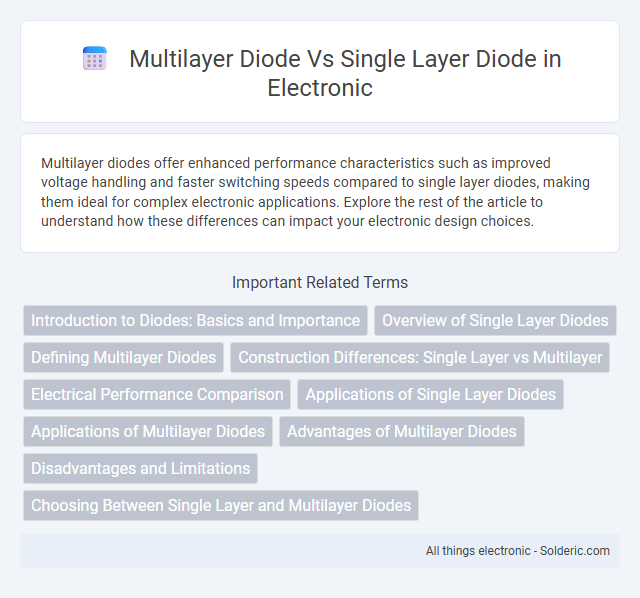Multilayer diodes offer enhanced performance characteristics such as improved voltage handling and faster switching speeds compared to single layer diodes, making them ideal for complex electronic applications. Explore the rest of the article to understand how these differences can impact your electronic design choices.
Comparison Table
| Feature | Multilayer Diode | Single Layer Diode |
|---|---|---|
| Structure | Multiple semiconductor layers stacked | Single semiconductor layer |
| Current Handling | Higher current capacity | Lower current capacity |
| Voltage Rating | Higher voltage tolerance | Lower voltage tolerance |
| Switching Speed | Slower due to multiple layers | Faster switching |
| Cost | More expensive due to complexity | Less expensive |
| Applications | High power rectification, protection devices | General purpose rectification, signal detection |
Introduction to Diodes: Basics and Importance
Diodes are essential semiconductor devices that allow current to flow in one direction, enabling rectification and signal modulation in electronic circuits. Single layer diodes typically consist of a single p-n junction, providing basic functionality with fast switching and low forward voltage drop. Multilayer diodes incorporate multiple p-n junctions, enhancing performance parameters such as breakdown voltage, current handling, and reducing noise, making them suitable for advanced applications requiring higher efficiency and reliability. Your choice between multilayer and single layer diodes depends on the specific electrical characteristics and demands of your circuit design.
Overview of Single Layer Diodes
Single layer diodes consist of a single semiconductor junction that allows current to flow in one direction while blocking it in the opposite, making them essential components in rectification processes. They typically feature simpler construction, lower manufacturing costs, and faster switching speeds compared to multilayer diodes. Understanding the characteristics of single layer diodes helps you select the appropriate component for applications requiring basic rectification or signal demodulation.
Defining Multilayer Diodes
Multilayer diodes consist of multiple semiconductor layers that create complex junctions for improved electronic properties, unlike single-layer diodes which have a simple two-layer structure. These multiple layers enable enhanced performance characteristics such as higher voltage handling, faster switching speeds, and better thermal stability. Understanding multilayer diodes can help you choose the right device for advanced applications requiring reliable and efficient semiconductor components.
Construction Differences: Single Layer vs Multilayer
A single-layer diode consists of a single semiconductor layer typically made of one type of material, forming a straightforward p-n junction for basic rectification. In contrast, multilayer diodes feature several alternating layers of semiconductor materials, enhancing electrical characteristics such as breakdown voltage and switching speed. Your choice between single-layer and multilayer diodes depends on the application's complexity and performance requirements.
Electrical Performance Comparison
Multilayer diodes exhibit superior electrical performance compared to single layer diodes due to their enhanced charge carrier mobility and reduced leakage current, resulting in faster switching speeds and higher breakdown voltages. The multilayer structure allows for improved control of the depletion region, which minimizes power loss and increases efficiency under high-frequency operation. Single layer diodes typically have simpler fabrication but suffer from higher forward voltage drops and lower tolerance to high current densities.
Applications of Single Layer Diodes
Single layer diodes are widely employed in basic rectification processes such as converting AC to DC in power supplies and signal demodulation in radio receivers. Their simple structure allows for efficient operation in low-frequency and low-power applications, including voltage clamping and protection circuits. Common use cases include LED indicators, low-voltage rectifiers, and sensor circuits due to their cost-effectiveness and reliability.
Applications of Multilayer Diodes
Multilayer diodes are essential in high-frequency and power electronics applications due to their superior voltage handling and fast switching capabilities, commonly used in RF circuits, voltage multipliers, and microwave detectors. Their multiple PN junctions enable enhanced breakdown voltage and improved surge protection, making them suitable for power rectification and transient voltage suppression in industrial systems. In contrast to single-layer diodes, multilayer diodes offer greater reliability and performance in complex electronic devices, including communication equipment and power supply units.
Advantages of Multilayer Diodes
Multilayer diodes offer superior performance due to their enhanced voltage handling capabilities and improved thermal stability compared to single layer diodes. Their construction allows for lower forward voltage drop and higher current carrying capacity, making them ideal for high-power applications. You benefit from increased reliability and efficiency in electronic circuits using multilayer diode technology.
Disadvantages and Limitations
Multilayer diodes exhibit increased complexity and manufacturing costs compared to single-layer diodes, often leading to reduced yield and higher defect rates. Their multilayer structure can result in greater electrical noise and slower switching speeds due to increased junction capacitance. Single-layer diodes, while simpler, face limitations in handling higher voltages and power levels, making them less suitable for high-performance applications where multilayer designs excel.
Choosing Between Single Layer and Multilayer Diodes
Choosing between single layer and multilayer diodes hinges on application-specific requirements such as voltage rating, current capacity, and switching speed. Single layer diodes offer simplicity and cost-effectiveness for low voltage, low current circuits, while multilayer diodes provide enhanced breakdown voltage, improved thermal stability, and faster switching for high-performance and high-frequency applications. Evaluating factors like power dissipation, response time, and device reliability helps optimize diode selection for efficient electronic circuit design.
Multilayer diode vs Single layer diode Infographic

 solderic.com
solderic.com